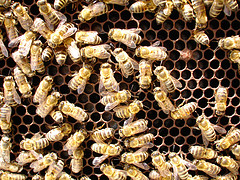


 Since 2004 we investigate nature inspired algorithms. The behaviour of ant colonies has already been successfully adapted for routing algorithms. But to the best of our knowledge, in 2004 nobody had tried to convey the well studied and highly efficent ressource-discovery and allocation pattern of honey bee colonies to the domain of information technologies.
Since 2004 we investigate nature inspired algorithms. The behaviour of ant colonies has already been successfully adapted for routing algorithms. But to the best of our knowledge, in 2004 nobody had tried to convey the well studied and highly efficent ressource-discovery and allocation pattern of honey bee colonies to the domain of information technologies.
Starting with the BeeHive project we have developed a highly adaptable and flexible, beeinspired routing algorithm, that exhibits a high throughput and fault tolerance. Later on we successfully adapted that algorithm to the domain of Mobile AdHoc Networking (BeeAdHoc) and traffic congestion avoidance in road networks (BeeJamA).
BeeHive is an efficient, scalable, adaptive and fault-tolerant routing algorithm, which was inspired from the foraging principles of honey bees. The communicative model of bees was instrumental in designing intelligent bee agents, which are suited for large and complex topologies. The results obtained from the extensive simulation experiments conclude that bee agents occupy smaller bandwidth and require significantly smaller processor time, however, even with such simple agens BeeHive achieves similar/better performance as compared to that of state-of-the-art routing algorithms like AntNet.
Read more about BeeHive...
Publications
BeeAdHoc provides a solution to one of the core dilemmatas faced by the mobile networking community: How to design a routing algorithm which is not only energy efficient but also provides a performance comparable with that of the existing state-of-the-art routing algorithms? BeeAdHoc could be classified as a reactive source-routing algorithm. The algorithm is simple and basically requires just two type of agents for routing: scouts and foragers. The foragers are carefully designed in such a fashion that they could be packed into the header of an IP packet.
Read more about BeeAdHoc...
Publications
Traffic congestions have become a major problem in metropolitan areas world-wide, within and between cities, in particular due to the highly dynamic character of congestion building and dissolving.
BeeJamA stands for Beeinspired TrafficJam Avoidance. It integrates the BeeHive routing algorithm, which exhibits high adaptability and flexibility, hight throughput and fault tolerance, into a distributed traffic control model, where vehicles are directed under decentralized control at each road intersection.
Read more about BeeJamA...
Swarm-based Navigation
Publications